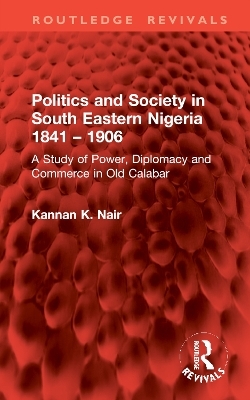
Politics and Society in South Eastern Nigeria 1841 – 1906
A Study of Power, Diplomacy and Commerce in Old Calabar
Seiten
2025
Routledge (Verlag)
978-1-032-98363-9 (ISBN)
Routledge (Verlag)
978-1-032-98363-9 (ISBN)
- Noch nicht erschienen (ca. Februar 2025)
- Versandkostenfrei
- Auch auf Rechnung
- Artikel merken
Originally published in 1972, this work draws attention to the interaction between the external agents of change (super cargoes, missionaries and consuls) and the changes that were going on in the internal political, social and economic structure of Calabar society.
For nearly 500 years Calabar has had one of the longest unbroken contacts with Europe of any port on the West African coast. Originally published in 1972, this book outlines the political and social development of Calabar during one of the most crucial periods of its history. While previous studies which have peripherally touched on Calabar have seen external factors as the most dynamic force in the 19th century history of the area, this work draws attention to the interaction between the external agents of change (super cargoes, missionaries and consuls) and the changes that were going on in the internal political, social and economic structure of Calabar society. The author assesses important aspects of contact between Africans and Europeans and discusses the use by Africans of Europeans as counters in their own political and economic rivalries.
For nearly 500 years Calabar has had one of the longest unbroken contacts with Europe of any port on the West African coast. Originally published in 1972, this book outlines the political and social development of Calabar during one of the most crucial periods of its history. While previous studies which have peripherally touched on Calabar have seen external factors as the most dynamic force in the 19th century history of the area, this work draws attention to the interaction between the external agents of change (super cargoes, missionaries and consuls) and the changes that were going on in the internal political, social and economic structure of Calabar society. The author assesses important aspects of contact between Africans and Europeans and discusses the use by Africans of Europeans as counters in their own political and economic rivalries.
Kannan K. Nair was Deptuy Dean of the Faculty of Arts and Social Sciences at the former University of Malaya.
1.Structural Organization of Calabar Society 2. Social Change, 1841-56 3. Internal Politics & External Factors, 1841-58 4. Economic Stress: The 1860s 5. Lineage Rivalries: The 1870s and 1880s 6. The New Structure of Power, 1885-1906 7. The New Economic Forces, 1885-1906 8. Conclusion: The Primacy of Internal Factors. Appendices: A. The Structural Genealogy of the Efik B. A Note on Efik Names C. The Volume and Value of Trade in the Bights of Benin and Biafra in the Nineteenth Century E. List of Towns Represented on the Native Council of Old Calabar, 1903 F. British Consuls and High Commissioners in the Bights.
| Erscheint lt. Verlag | 1.2.2025 |
|---|---|
| Reihe/Serie | Routledge Revivals |
| Zusatzinfo | 4 Illustrations, black and white |
| Verlagsort | London |
| Sprache | englisch |
| Maße | 138 x 216 mm |
| Themenwelt | Sozialwissenschaften ► Politik / Verwaltung ► Vergleichende Politikwissenschaften |
| Sozialwissenschaften ► Soziologie ► Spezielle Soziologien | |
| ISBN-10 | 1-032-98363-9 / 1032983639 |
| ISBN-13 | 978-1-032-98363-9 / 9781032983639 |
| Zustand | Neuware |
| Haben Sie eine Frage zum Produkt? |
Mehr entdecken
aus dem Bereich
aus dem Bereich
Geschichte, Parteistruktur, Radikalisierung
Buch | Softcover (2024)
UTB (Verlag)
CHF 38,95


